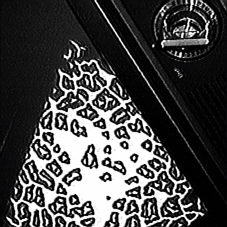
These planet-like images were rapidly rotating, with structures flowing from the north pole. You can see that the rotation was extremely rapid: each bright blob was taken to the next in 1/30th of a second.
With a good camera and a bad TV you can create a wide variety of kinds images by having the TV show what the camera sees and pointing the camera at the TV. Two things create most of the effects: the angle of the camera with respect to the image on the screen, and the relative size of a pixel on the TV screen and the image of a pixel on the TV screen. To a lesser extent, lighting and images of other things, such as the side of the TV set, play a role.
The live video, at 30 rapidly evolving frames a second is really weird. I can't overstate just how weird it is. It's a lot weirder than these stills, that's for sure.

These planet-like images were rapidly rotating, with structures flowing
from the north pole. You can see that the rotation was extremely rapid:
each bright blob was taken to the next in 1/30th of a second.

These images evolved extremely rapidly, from fine to coarse structures and
back again about every 3/4ths second. Note sierpinski-like details. Click
for another image from this sequence.

This was definitely the wierdest part of all. The image is rapidly rotating
and dilating out from its center and contracting along its edges.
Click for an image taken after the
camera was shifted somewhat, breaking up the long strands.
Here are another 5 completely different kinds of things!
Chaim Goodman-Strauss Dept. Mathematics Univ. Arkansas Fayetteville, AR 72701 cgstraus@comp.uark.edu 501-575-6332